Software testing techniques, methodologies and tools are always changing.
Blame the emerging technologies and new platforms or accuse the advancement of new devices!
Truth of the matter is, businesses around the world are transforming and so are their IT systems and software testing world is not immune to this phenomenon.
Zephyr conducts an annual survey wherein 6000+ of its customers in 100 countries take part to answer some interesting questions to prepare a report.
This year around 500 of testing professionals participated in this survey from different companies across the globe to represent the general consensus of how different software testing teams across the world test, what tools do they use and what challenges they face.
It is a great way to determine where the software testing industry is headed and what are the latest trends in software testing in 2015 and for the coming years.

Now, these challenges and issues might be related to the tool-set the teams use or testing methodology that they adopted for their testing operations.
I am pretty sure that you will find your (or your team’s) situation in one of the cases in this report and will make you think how is your problem listed in this survey when you didn’t even participate! 😉
The findings on the report are quite interesting!
So, what I thought is to go through this report and try to come of with some pointers to help you understand what your focus should be in the coming years if you plan to take up a career in software testing field.
Latest trends in Software Testing – How does the world test?
To excel in any field, it is of umpteen importance to understand what is going on in the industry.
If you are already in this area and are planning to further level up your skills in software testing tools, emerging trends and methodologies, this article (and the report on which this article is based on) should help you in making those decisions.
So let’s get started and start having a look at some crucial findings from this report!
1. Less than 60% teams were half-way agile and less than 30% completely!
Agile testing – it means so many different things to different people.
Though Agile seems to be the next step forward to ensure faster time to market by allowing teams to deliver in smaller increments and more often, more that 60% respondents on this survey thought they were half-way agile.
Only 30% of the survey participants felt they were completely agile.

These results seem a bit surprising to me.
The reason is – Agile has been around for almost a decade now and majority of teams run using Agile methodologies. Many of those teams have been using Agile day in and day out.
Interestingly, if 60% of them still think they aren’t agile yet, is it the lack of confidence or is there still some bias around what is agile and what is not?
Maybe, we could say they are still somewhere between Waterfall and Agile – probably “Agile-ish”?
Also Read: Benefits and challenge of exploratory testing in agile
As per the survey conducted by Zephyr, the major reason was Process – not having a process at all, or having it but not implementing it, implementing it but not doing it right or the entire team not following it.
Around 70% of participants thought Process was the main reason that is holding back teams to be agile, followed by tools which 18% thought to be the reason.
Also Read: 8 essential Firefox add-ons for testing
Other responses below from the report.
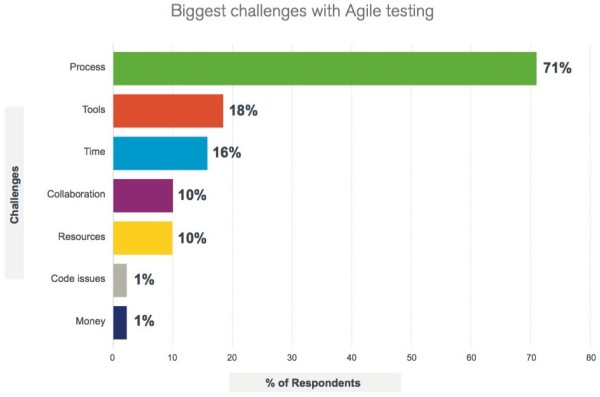
Another reason could be that the teams who think that they are less that half-agile have just gotten started and there is a long transformative journey ahead?
The survey participants were quite diverse ranging from small, medium and big enterprises. So, I don’t think the data set is generalised to only small teams in a start-up or only to big organisations who have corporate environment to influence decisions.
If you find yourself in the group of 70% people who think they are not completely agile, don’t worry too much as you have around 70% of the world teams with you who are trying everyday to make changes to reach as close to calling themselves completely agile as possible.
There are many tools and resources out there to help you in your Agile journey. Training your resources for Agile, defining the processes for the team to follow and using Agile specific tools could be a real good start.
“Rome wasn’t built in a day”
So stay focused!
Do drop in with your views in the comment section below to let me know what you think of this surprising finding…
2. Clouds haven’t yet poured on the Testing World – 50% still use internal test environments!
This is quite surprising that adoption for cloud-based test environments is still not very popular based on the results that have come out as part of the survey, considering it is 2015.
With the lightning rise of cloud-based solutions over the last 5 years in other sectors, cloud-based on-demand test environment solutions have still not been adapted by many teams – just 15% use public or private clouds.
Around 30% of these participants use a mixture of both cloud and internal systems. So, it seems the tide may slowly start to turn with more and more teams adopting cloud test environment solutions.
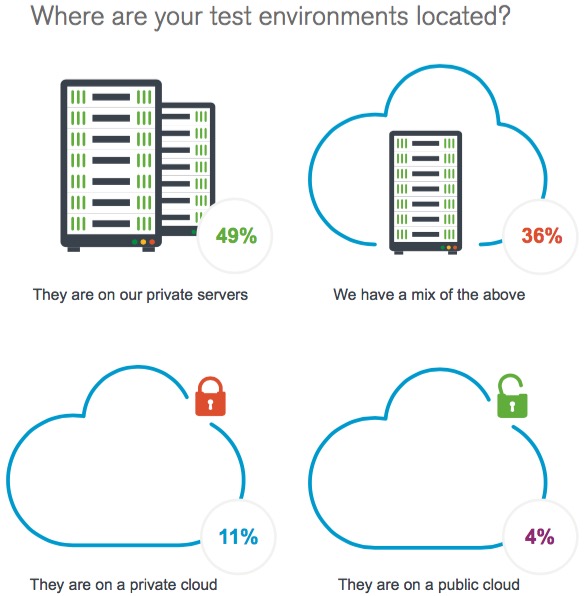
Cloud-based test environments allow to provision unlimited on-demand 1-1 test environments for testers that could be switched ON or OFF as required.
If you are on one of the teams who still use internal private servers for test environments, you should consider moving to cloud-based test environments soon as it would help you increase your automation footprint, have on-demand dedicated test environments for different activities and dramatically cut costs.
3. Only around 35% of teams manage their own test environments!
Around two-thirds of participating test teams have IT and development teams handling test environments for them.
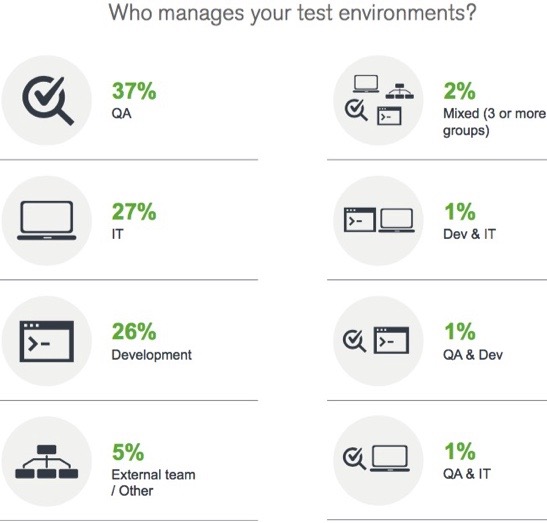
While this traditional way of managing test environments might work, this creates a dependency on other teams to get your test environments ready hence, slows down testing.
Technical and complex tasks for test environment set-up might not be in the QA team’s territory and must need a separate technical team. However, wherever possible, creating test environment instance should be controlled by testing teams to speed up processes and to eradicate dependencies on other teams.
As a QA team, you should start taking more control of test environments and as I mentioned above, making use of cloud-based test environments and creating on-demand test instances is the way-forward.
4. 30% of teams have no Mobile Testing at all!
Another astonishing finding on the survey report is that around 30% of testing teams don’t cater to mobile device testing at all.
Sounds weird, right?
Remember, there are millions of applications out there on different operating systems.
Considering that, it is quite shocking though that less than 10% of the testing population spends more than 50% of their time testing on mobile devices.
Looking at this revelation, there is definitely a lot of room for improvement and increased test coverage on mobile devices.
Another question asked as part of this section was to the teams “When it comes to mobile apps and mobile-enabled applications, do you have the right tools?”
To this, 65% answered NO.
“The biggest room in the world, is the room for improvement”
So, it is about time to start researching mobile testing tools to figure out what works best for you. If you fall under this category, start small and search for the mobile testing tool in the market that fits your needs.
5. 60% of testing population tests for Internet of Things (IoT). 42% do not test for IoT at all!
Testing for devices (read “Things”) that are always connected has now got a fancy moniker “Internet of Things” but it has always been there.
Around 60% of the testing population on the survey had some level of testing related to Internet of Things.
This is interesting!
Considering it is a fairly new category, IoT has shown a rapid adoption rate from a testing perspective.
BUT, looking at the graph below this also means that north of 42% of the testing teams aren’t doing Internet of Things testing at all.
Fad or trend, new fancy moniker or same-old-testing-of-connected-devices, IoT testing is expected to grow significantly as new higher quality always-connected devices are introduced.
6. Only 11% testing teams have more than 70% of their test repository automated and around 10% have 50% automated!
Automated testing – it is the latest trend in software testing with all teams being pushed to deliver faster time-to-market and more frequently than ever.
In this category, the survey put forward a simple question to the participants “How much of your testing repository is automated?”
Results are realistic and shocking (sad, to be honest!)
Only 11% of participating testing teams have more than 70% of their test repository automated and only 3% of them have above 90% automated.
Testing industry is quite matured now but this is one area which we have been grappled with since forever.
We know automation is the way-forward, we should focus at automating right from the start, and we have a ton of open-source, commercial tool sets available which should make it easy to automate.
Yet, it is quite surprising from the survey that around 37% of the teams have very little or no automation suites at all.
Also Read: Best open source load testing tools
7. Around 50% of the teams use more than 1 automation tool (sometimes 3-4) and 42% use Selenium!
This question on the survey is again related to automation.
This one was around asking the teams how many tools are they using to meet their automation needs.
Around 50% of the participating teams use more than 1 automation tool (many use even 3-4 different tools and frameworks) to cater to their situation as sometimes a single automation tool might not be enough.
When asked which tools/frameworks are the teams using, around 42% of teams use Selenium. Below is the detailed finding on the report.
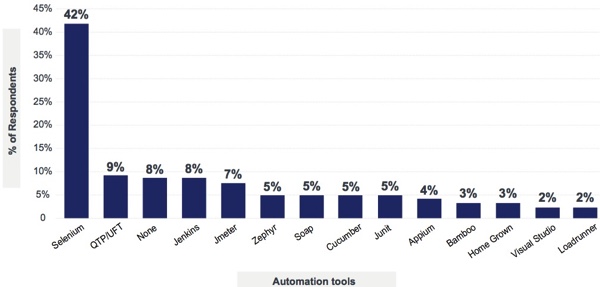
I hope this survey gives you a realistic picture of the latest trends in software testing in 2015 and how the world tests.
Many finding were eye-opening revelations, some of which we already know, some were enfeebling and some desolating.
This report and the review of it in this article should also help you understand where software testing as an industry is headed in 2015 and for the coming years. What we make out of it is, there is some tremendous amount of activity going on and that it is evolving.
It should also help you decide which path to take in your software testing career because when you know where an industry is headed, you can take various steps to level up your skills accordingly.
I hope you enjoyed reading my review of this report and will try to implement the learnings from this in your daily testing life. Do let me know what you think of these findings in the comments section below – I love interacting with my readers. 🙂To your success!
Happy testing…
Disclaimer: The images in this post have been used from Zephyr’s annual survey report “How the world tests 2015.” QST doesn’t hold or claim any copyrights to these images. You can download the original report using the download button above.

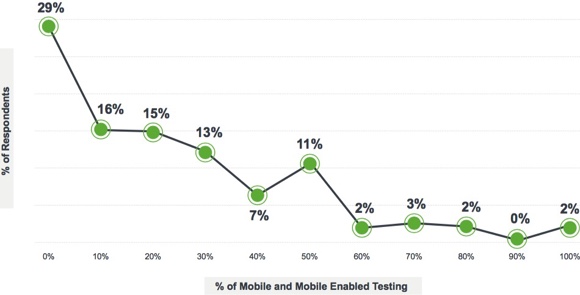
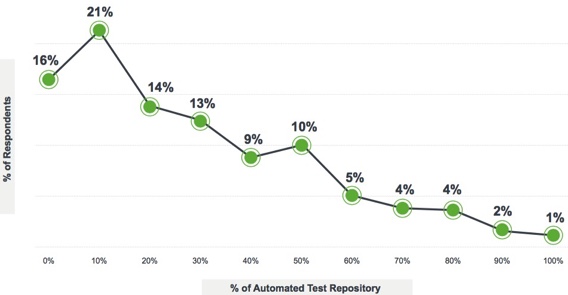





Hi, thank you for this post I agree with you that businesses around the world are transforming and so are their IT systems and software testing the world is not immune to this phenomenon. very useful information
Nice Information Sir, feel very glad after read this, You have good analytical skills, you shows from this article.
Thank for sharing this information with us
Thanks Suraj, I am glad you found this useful 🙂